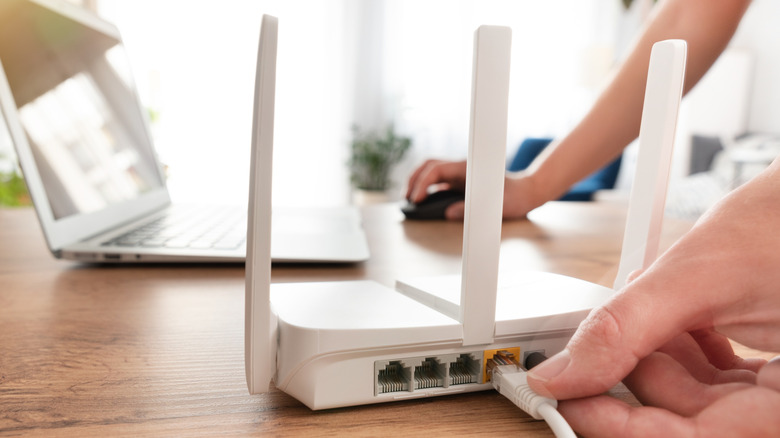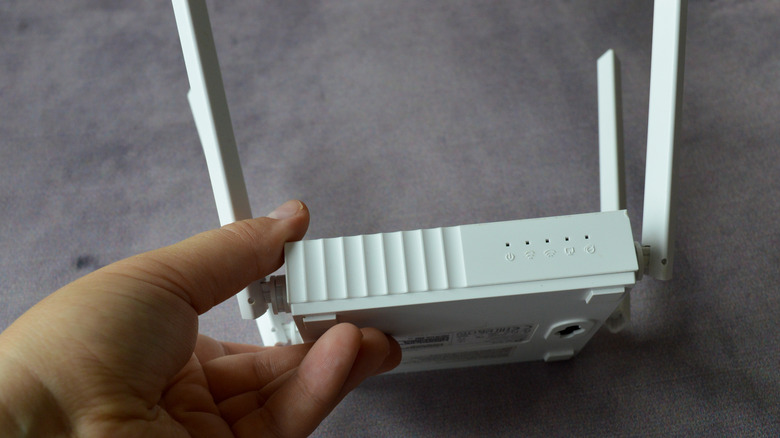Everything You Need To Know About Wi-Fi Antennas (And How To Upgrade Them)
We may receive a commission on purchases made from links.
A strong and reliable Wi-Fi signal has become a necessity for modern-day homes and businesses. As such, many of us are going to great lengths to pay for the highest internet speeds that providers offer. But even with top internet speeds, chances of experiencing sluggish Wi-Fi and dead zones are still high, and this can be quite frustrating.
While several things in your home might be ruining your Wi-Fi connection (say, an old router or physical obstructions), there is one component that we always forget to check: the Wi-Fi antenna. The sole purpose of a Wi-Fi antenna is to serve as a translator between your gadgets and router. It picks up the radio waves flying through the air and ensures that the signal reaches your devices by sending and receiving wireless signals. Without them, your router will not be able to broadcast your internet across your sitting room, let alone through multiple floors and walls. Given its crucial role, however, this gadget can become a bottleneck for your internet speed.
Just like other tech gadgets, Wi-Fi antennas will wear out or get damaged over time. When this happens, their performance will drop, leading to a poor internet connection. And if you notice a sudden drop in your Wi-Fi connection, don't invest in a new router first. Instead, check the antennas, as they might be the culprit. Testing is quite simple: position your router in a central location away from barriers and check your Wi-Fi signal strength with an analyzer app. If the signal is still weak, upgrading or replacing your Wi-Fi antennas with powerful ones will dramatically improve the performance of your network.
What are the different types of antennas you should know about
If you've searched for new Wi-Fi antennas, you may have found that there are a lot of different choices out there. That's why, before you go ahead and replace your antennas, you'll first want to understand the different types of Wi-Fi antennas. It will help you choose a smart upgrade that will truly improve your home signal.
Omnidirectional antennas are the most well-recognized type of Wi-Fi antenna, with the BingFu Dual Band Wi-Fi, which sells for $5 on Amazon, being one of the most affordable. These antennas are ideal for large settings where devices are scattered throughout the space around the router, as they're designed to distribute the Wi-Fi signal in all directions.
Then there are directional antennas. As the name suggests, these devices work by focusing the signal in a specific direction (or in patterns of 35 to 60 degrees). Because of this, they're usually perfect for long-range point-to-point connections or targeted coverage areas that need extra attention. In addition to that, their long reach makes them one of the most affordable options for extending your Wi-Fi range outside your home.
How to upgrade your Wi-Fi antenna
Upgrading your Wi-Fi antenna might sound like a job for an expert, but in most cases (and with the right tools), it's pretty simple. However, you shouldn't jump into replacing the antennas because not all routers support external upgrades. While some might have detachable antennas (like SMA or RP-SMA), some newer Wi-Fi 6E models have integrated antennas due to regulatory constraints.
Once you've determined that your router has detachable antennas, choose the right replacement antenna depending on your needs. When you're ready, unplug the router from the wall and disconnect everything that's connected directly to the router. Next, carefully unscrew your router's antennas and then reattach the new antennas to the router.
When you're done, don't just place the router back in its position. You'll want to experiment with different areas. You should put your router in a centrally located position that's clear of obstacles. Also, try to position the router in an elevated position to maximize your Wi-Fi signal. And if you're aiming for better performance, you might consider other solutions like installing Wi-Fi extenders or Wi-Fi boosters.


